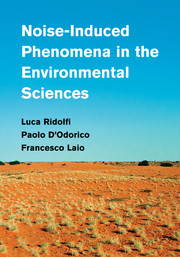Book contents
- Frontmatter
- Contents
- Preface
- 1 Introduction
- 2 Noise-driven dynamical systems
- 3 Noise-induced phenomena in zero-dimensional systems
- 4 Noise-induced phenomena in environmental systems
- 5 Noise-induced pattern formation
- 6 Noise-induced patterns in environmental systems
- Appendix A Power spectrum and correlation
- Appendix B Deterministic mechanisms of pattern formation
- Appendix C List of symbols and acronyms
- Bibliography
- Index
4 - Noise-induced phenomena in environmental systems
Published online by Cambridge University Press: 05 August 2011
- Frontmatter
- Contents
- Preface
- 1 Introduction
- 2 Noise-driven dynamical systems
- 3 Noise-induced phenomena in zero-dimensional systems
- 4 Noise-induced phenomena in environmental systems
- 5 Noise-induced pattern formation
- 6 Noise-induced patterns in environmental systems
- Appendix A Power spectrum and correlation
- Appendix B Deterministic mechanisms of pattern formation
- Appendix C List of symbols and acronyms
- Bibliography
- Index
Summary
Introduction
Environmental systems are typically forced by a number of drivers, such as climate and natural or anthropogenic disturbances, that are not constant in time but fluctuate. With the exception of processes dominated by deterministic oscillations (e.g., daily and seasonal cycles), a significant part of environmental variability is random because of the uncertainty inherent in weather patterns, climate fluctuations and episodic disturbances such as hurricanes, landslides, earthquakes, fires, insect outbreaks, and epidemics (e.g., Ludwig et al., 1978; Benda and Dunne, 1997; D'Odorico et al., 2006b; Gilligan and van den Bosch, 2008). The recurrence of random drivers in biogeophysical processes motivates the study of how a stochastic environment may affect and determine the dynamics of natural systems.
Over the past few decades a number of studies have contributed to the observation, understanding, and modeling of stochastic processes in different areas of the biological (e.g., Bharucha-Reid, 1960; May, 1973; Tuckwell, 1988) and earth sciences (e.g., Krumbein and Graybill, 1965; Yevjevich, 1970; Bras and Rodriguez-Iturbe, 1994; Hipel and McLeod, 1994), leading to the development and application of several modeling frameworks for the study of random environmental fluctuations. This rather rich body of literature can be divided into two major classes, depending on the role played by noise in the dynamics of natural systems. In Chapter 3 we showed how random environmental drivers may either cause stochastic fluctuations of the system around the stable state(s) of the underlying deterministic dynamics (disorganizing effect of noise) or induce new dynamical behaviors and new ordered states (May, 1973; Horsthemke and Lefever, 1984) that do not exist in the deterministic counterpart of the process (organizing effect of noise).
- Type
- Chapter
- Information
- Noise-Induced Phenomena in the Environmental Sciences , pp. 98 - 166Publisher: Cambridge University PressPrint publication year: 2011
- 2
- Cited by



